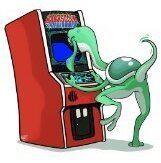
After washing the board, my first thing was to attend to the missing parts. It was missing a 9316 (Really a 74161 counter), a 74ls04, and an Intel 3245. The intel 3245 has become a bit more difficult to get a hold of as it was discontinued quite some time ago. So this was actually an opportunity to try to use a Soviet equivalent, which could be obtained for much cheaper because there is more NOS of that left behind. For this I used the K170AP4.
Another part that I noticed was missing was the 180pF tuning capacitor that was used to help the crystal oscillate. Unfortunately, I did not have that particular value available. I did however, have a bunch of 56pF capacitors. You can add capacitance by putting capacitors in parallel, so I solder three of them to leads and soldered them onto the board to get 168pF, which is probably close enough.
After replacing all the missing parts, I found that the game had a dead short on the 12V rail, which is obviously no good. One way to kind of narrow down a short like this is to utilize your multimeter if it is sensitive enough. The closer you get to the short, the lower the resistance will be. First place I checked was the tantalum capacitors, as those have a tendency to short out. It ended up being one of the tantalums by the RAM (shown below). I removed it and replaced it with an electrolytic that I had since I don't stock tantalums.
After the power situation was taken care of, I hooked it up to find that it booted to garbage. First thing I did was reseat the ROMs and the CPU as midway loved to use bad single wipe sockets.
After reseating the chips, the game fired right up and worked as it was supposed to, another board back from the dead! It's always a shame to see people use these things for parts. Sometimes it's difficult, especially with custom chips and whatnot.
- Read more...
- 0 comments
- 459 views

